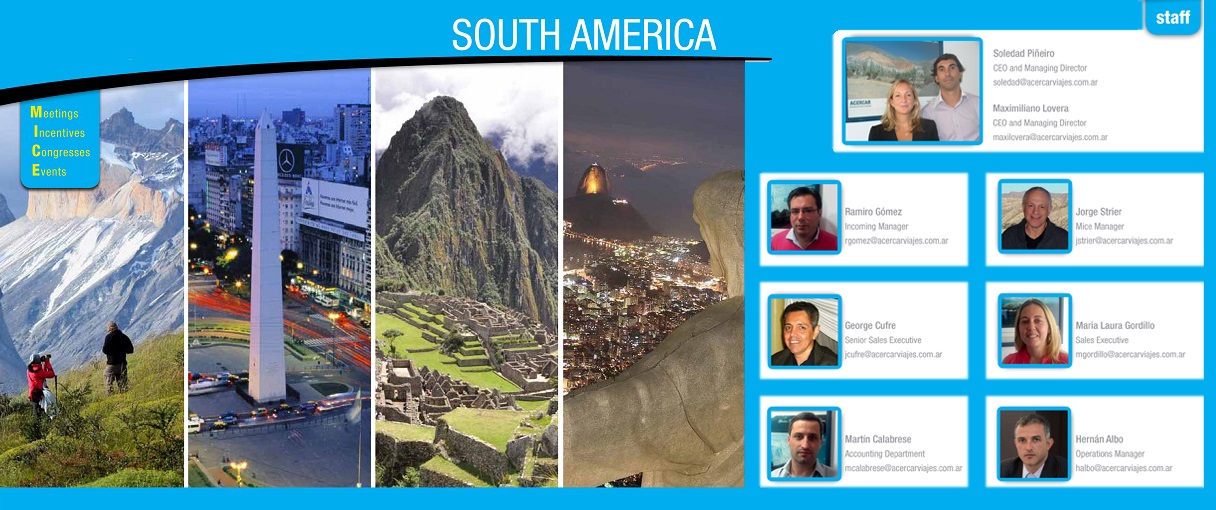Motivational activities, using unique and creative resources, are constantly growing in importance at a worldwide level. Incentive trips have great emotional impact. They are carefully organized and designed to meet the needs of our customers and, as a distinctive element, they include coordinated activities. These powerful moments will remain in your internal and external customers’ minds.
Goals:
Incentive trips are a tool to reward the performance of employees, recognize the aims and benefits achieved (including suppliers as well as customers), reinforce dynamism, motivate work teams, cultivate a sense of belonging, help to communicate a message about the future of the company and take risks; moreover, incentive trips help develop creativity to solve problems in adverse or unknown environments, foster competitiveness, and reinforce the company’s actions.
BENEFITS OF INCENTIVE TRIPS
The benefits of incentive trips, in comparison with other types of incentives, are indisputable: “Everyone likes travelling, it is a reward no one wants to miss”. Cash rewards are spent to pay debts or on day-to-day living expenses, they do not offer pleasure or satisfaction, so the reward to a specific effort is related to daily issues. Gifts are not always to the taste of the recipient; in fact, if they are not liked, they may be counterproductive.
• A trip motivates employees, taking them out of their daily routine.
• A warm and relaxed environment facilitates the presentation of new products and strategic plans.
• A trip is an unforgettable experience for participants.
• A trip creates unique group and personal moments of concentration, relaxation, introspection and deep thinking, which improves participants’ state of mind and spirit. All that energy is then expressed in daily activities.
• A trip creates a special sense of camaraderie. People who do not have a close relationship at work, for hierarchical or any other reasons, may embark themselves on the same adventure and get to know and appreciate each other. It makes it easier to communicate with each other.
• Unlike other rewards, a trip is an investment for the company because travel expenses are repaid with an improvement in employee performance and client-company relationship.
OUTDOORS
Half-day or full-day events with activities outside the company for work groups, training courses or recreational events, where executives and employees can perform outdoor activities co-ordinated by specialists with different purposes. This format is increasingly accepted in the corporate environment because it offers multiple benefits in comparison with events organized inside the company. These events are almost a reward. Employees have a positive attitude towards them because they feel valued, teamwork is naturally adopted and, more importantly, employees get home happy, which is a great benefit for the company. Happy employees are 30% more productive and generate a synergical multiplier effect which contributes to the growth of the company.
Goals:
Build internal and external customers’ loyalty, strengthen interpersonal relationships, build teams and coach employees, improve communication and social competitiveness, develop leadership skills, team cohesion, motivate and improve personal skills, foster strategic thinking and adaptation to work under pressure, analyze behavior, reaction and creativity when facing imponderable situations.
The following activities address different needs and goals established by companies.
|
Land |
Water |
Winter |
| Treasure Hunt Flag Theft Relay Races Corporate Triathlon: cycling, horse riding, quad biking Adventures in Nature Bonfires Indian Attack Train Robbery Adventures in Nature Against the Clock Intercompany Sports Tournaments Mountain Activities Paint War Paragliding |
Yacht Races |
Racket Trekking |
CORPORATE EVENTS
The fact that an event unfolds without difficulties does not mean the event was a success. The goal is to make these events last in the memory of participants and attendants. To achieve this, an increasing number of companies decide to leave behind traditional environments to innovate and use places that are typically destined to other activities, thus creating a unique framework that complements the event and the goals established. For an event to become a special occasion it is necessary to carefully choose a venue that suits, not only the needs of the company, but also the expectations of participants. Nowadays, more and more companies look for that touch of distinction and choose to organize their actions in unique places. Some examples of this service include parties to celebrate the end of the year, openings, goals achieved, galas to honor executives and customers, etc., as well as events to launch products or present strategies, hold corporate olympics, training courses or indoor activities. All these events are opportunities to surprise participants with originality and taste, always taking the company’s budget into account.
Goals:
Reinforce company’s actions, communicate, promote the company, seduce customers, and add value to products.
Business Events and Meetings in the Corporate World:
• Product Presentations
• Open-House Visits (Customers, Foreign Executives, Salespeople, etc.)
• Openings
• Showrooms
• Fashion Shows and other Events
• Press Conferences
• Induction Courses
• Integration and Recreational Events
• Brainstorming Events
• Family Day
• Representation of the company in Tournaments, Competitions, World Championships, etc.
Business Events and Meetings outside the Corporate World:
• Business Breakfast, Lunch, and Dinner
• Product Promotion and Presentation
• Meetings and Lectures
• Meetings of Companies, Associations, etc.
• Showrooms
• Press Conferences
• Company Parties and Celebrations
• Parties to Celebrate Goals Achieved
• Anniversaries (Company, Products, etc.)
• End of the Year Parties







